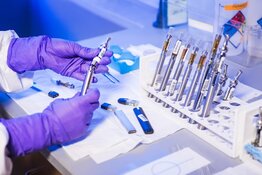The Life Sciences Report: Steve, I know that you believe we're in a biotech bubble right now. The NYSE.Arca Biotechnology Index (BTK) is up 33% over the past year, and 132% over the past two years. The NASDAQ Biotechnology Index (NBI) is up 57% and 99% during those corresponding periods. Biotech has performed quite well. Why do you think we're headed for trouble?
Steve Brozak: The problem I have with looking at these new therapeutic modalities as investments is that they don't lend themselves to general biotech stock and index buying. As a result, the fund managers who are investing in something as simple as the BTK or other indices aren't really participating in what's truly breakthrough. The reason for that, frankly, is that these managers can't discern one pipeline from another or one new therapeutic approach from the next. That's why I think we're headed for trouble.
TLSR: Between May 8 and May 12, the Wall Street Journal conducted a survey of private economists. About 73% of these economists believe there will be a hike in the federal funds rate at the Federal Reserve's mid-September meeting. That number, by the way, is up from 65% in April and 38% in March. If the Fed does tighten, might that be the trigger that causes stocks to correct?
SB: At Columbia Business School, they always taught us that if you ask two economists for an opinion, you get three different answers. So, for all intents and purposes, when you see 73% of economists agreeing on something, you should be very, very careful.
However, Fed Chair Janet Yellen was the first person at the Fed to go on record talking about a biotech bubble. Obviously, she's been wrong so far. The point I'm making here is that at some point there has to be recognition of the forces of interest rates and gravity. I helped produce a film about the Federal Reserve about 18 months ago called Money for Nothing: Inside the Federal Reserve. Liev Schreiber is the narrator, and we interviewed former Fed Chair Paul Volcker, then Vice-Chair Yellen and many others. You can watch it free on Netflix. It contains what I believe are important insights and history that will, I hope, guide us forward in monetary policy.
"Investors should understand biotech versus just making blanket assumptions and getting into index funds."
We'll see at the Fed's upcoming meeting, but a rate hike will drive money away from the equity capital markets, including the biotech sector, causing any momentum in stocks to decline. However, Chair Yellen has been broadcasting the message to allow the market to exercise its own judgment; her timing was way off on biotech, as it roared forward. Still, we may be seeing the start of a correction now, and so investors should make decisions today to help ease whatever the effect will be. In doing so, the market should begin to reflect the fact that rates are going to increase, essentially pricing in the anticipated effect of monetary policy. On a day-to-day basis, borrowing and the cost of capital will have to rise for biotech.
TLSR: Biotech pipelines are prolific today, full of newer therapeutic modalities and agents—especially the immunotherapeutic candidates—that have set the stage for a tremendous decade of drug discovery and development. Isn't that bullish?
SB: Yes, immunotherapy is a very bullish theme. What's different in this area now is that, for the first time, we have the ability to actually control and contain immunomodulation, which is something that has never existed before. In fact, clinicians have experimented with immunotherapy for the last 125 years, going back to the efforts of Emil von Behring and Shibasaburo Kitasato in Robert Koch's lab. The difference between now and then is that we have more tools and knowledge to employ when we manipulate viruses and cells to do our bidding, without doing as much damage. When investigators and clinicians did work in decades past, it was with patients who had no hope. Of course, today, we can't do things like that. It's not practical, and frankly, it's difficult to get any kind of reproducible results. However, these days, understanding the science and the mechanisms of action makes an incredible difference in what we can do and how we do it.
TLSR: Should investors flee biotech and come back later? How should investors approach this bubble problem?
SB: Here's the critical point about biotech right now: Currently there is no meaningful return for anyone investing in the "gilt-edged" treasury, or equity securities and their ilk. The money is flowing into biotech funds and indices. That's where the bubble is coming from. I think investors should understand biotech versus just making blanket assumptions and getting into index funds, or even individual names, because of the bandwagon effect. For instance, not every ride-hailing app is the next Uber. The same goes for immunotherapy companies. If a money manager is overseeing $5 billion ($5B) in healthcare assets, he or she is, almost by definition, an indexer. How is that fund differentiated from an index? Investors need to look for today's technological innovators, and understand what they do. This is the important decision people need to make before investing.
So, should investors go away and come back to biotech later? No. I would actually put it this way. Investors can make a great deal of money if they possess discerning skills in biotech investing. Plenty of short ideas will present themselves and, with no small irony, there will also be breakthrough companies that will make headlines. The closing warning that I would emphasize is that large pharma is no longer a safe haven, where you can expect the automatic returns funds have relied on.
TLSR: Over the next decade, we're going to see some quite substantial gains related to innovative agents that could actually cure patients—likely in monogenic (single-gene) disorders such as beta thalassemia and sickle cell disease. Some of these names have very high valuations right now. Do investors buy these names and stick with them?
SB: You mean names like bluebird bio Inc. (BLUE:NASDAQ), for instance? Let's talk about bluebird. It has pretty much become a bellwether because it's priced so high, with a $6B market cap today, and it is up six- or sevenfold over the last 12 months. What bluebird got back in March 2013 was validation of its CAR T-cell program in hematologic and solid tumors from Celgene Corp. (CELG:NASDAQ), one of the largest, most successful biotechs out there. People measure success, or share price appreciation, by the bellwether.
But investors need to understand that we are talking about therapies that are years away from actual commercial adoption. However, when you see successes along the way in development, it reinforces investor confidence. It can also dissipate investor confidence when there's a bump in the road. That's an important consideration because investors tend to throw out the proverbial baby with the bathwater.
"Immunotherapy is a very bullish theme."
Two years ago the company initiated a Phase 2/3 study in childhood cerebral adrenoleukodystrophy (CCALD). It’s an open-label trial with just 17 patients. CCALD is an ultraorphan disease occurring in boys, and it leads to death. The Lenti-D agent is a gene therapy using the patient's own hematopoietic stem cells, which are transduced with the lentiviral vector to encode a human gene, ABCD1, to be transplanted back into the patient. Final data collection will occur in the summer of 2018.
The company has a Phase 1/2 trial, HGB-204, in beta thalassemia major with its LentiGlobin product. This is a U.S. trial with 17 patients. These beta-thal patients require transfusions to maintain their red blood cell counts so they won't be anemic. The first few patients treated did not require any further transfusions after the treatment. The Phase 1/2 HGB-205 beta thalassemia trial is also open label; it's a French trial with fewer patients—about seven subjects. It will collect final data at the end of 2017.
Then, of course, bluebird has the Phase 1/2 sickle cell disease trial—again, a small trial—that will have about eight patients, but it's too early to draw any conclusions from data so far.
I advocate bluebird as a Buy. The company's current valuation is high, but is it overvalued? An argument could be made that bluebird could go either way. Based on some incredible initial results (albeit from limited clinical trials), the pedigree of the technology from Baylor College of Medicine's cellular therapy labs, and the recent news on FDA granting a clear regulatory pathway for the company, that makes bluebird look very promising. There is great risk, however, that we may begin to see more adverse events, or other unintended consequences of the therapy, as the trial is expanded to a larger number of patients. This risk, and the associated blow the company may be dealt from such a setback, should be considered before making an investment.
TLSR: Can you talk about some other names you like?
SB: Yes, sure. I've discussed Celldex Therapeutics Inc. (CLDX:NASDAQ) with you in the past. The reason I believe it's a safer immunotherapy play is because you're dealing with known quantities. One of Celldex's primary programs is a peptide vaccine in glioblastoma; such vaccines are known to be safe and highly effective in inhibiting the ability of cancer cells to function. The other program is a monoclonal antibody candidate. Monoclonal antibodies are already on the market for a variety of diseases. Both medically and commercially, these two products are very well understood, with commercial pathways and manufacturing processes.
Of all the immunotherapy plays, I would say this one stands very, very high over the crowd. It is late phase, and many of the questions have been answered. Now it's mostly about efficacy. Celldex's valuation has gone up, but it has not gone up exponentially, like bluebird's, in the last 12 months.
TLSR: About 54 weeks ago, you put a $30/share price target on this stock, and it went through that to nearly $32/share. Now, even with a significant pullback, this stock is still up about 90% since then. How much more can we expect from Celldex? What's your target price now?
SB: What is a new-generation approved product worth? Now you're starting to talk about multiples. The question just becomes, "How much?" Celldex has data coming out, and when I see the data, I'll tell you what I think it could be worth. Right now, we'll leave the target at $30/share, and when we start to see some news, I'll announce my new price objective.
TLSR: The company has a pivotal Phase 3 trial called ACT IV in progress for a specific gene variant. About 30% of glioblastoma patients express this mutant gene, called EGFRv3. It's a 740-patient trial, and final data will be collected in November 2016. The agent being studied is Rintega (rindopepimut). Given that Rintega has received breakthrough therapy designation from the FDA for this very specific indication, how long could it take to get approval if the Phase 3 data are favorable?
SB: That is a remarkably good question that the FDA needs to consider. I'm not going to speak for what Celldex management is doing, but what I will say is this: We are hearing about patients who have been on Rintega who are speaking, walking and still alive. In looking at the control group, they are not alive. At what point does the FDA say, "We've passed beyond the realm of statistical certainty here, and now we are looking at a precedent-setting agent, the likes of which we have not seen before for this deadly disease." I'll leave it at that. The only other thing I'll say about Celldex is that it has one of the most competent management teams I've ever seen, in any biotech of any size.
TLSR: Before we get final data on this ACT IV trial, do you expect several rounds of data for both Rintega and other programs that the company is currently running?
SB: Yes, I would expect to see interim announcements and data points. Again, about management at Celldex, you're talking about a team that has shown itself to be exceedingly flexible and adroit in making sure that shareholders are kept informed.
TLSR: You just participated in a financing for Navidea Biopharmaceuticals Inc. (NAVB:NYSE), a company you and I have spoken about before. Tell me about that.
SB: We just acted as a financial adviser on a debt round for the company to ensure it had sufficient funds to get it to breakeven. Navidea's product, Lymphoseek (technetium Tc99m tilmanocept), is a receptor-targeted radiopharmaceutical being used in hospitals during actual surgeries to find and delineate CD206 in the lymphatic system for the presence of solid tumors. The idea is to prevent progression, metastasis and recurrence. If you can "see" the disease via a gamma detector that the surgeon scans the tissues with, then you have a better chance of long-term success, meaning survival.
"People measure success, or share price appreciation, by the bellwether."
Currently, Lymphoseek is the only product approved for sentinel node mapping in breast cancer, melanoma, and most recently head-and-neck cancers. It is also approved for use in lymphatic mapping of all solid tumors, meaning the bigger pie is lymphatic mapping, which is the nexus for more than 1 million new cases of cancer in the U.S. alone. That was one of the central premises for being able to borrow money from CRG (formerly Capital Royalty Group L.P.), which provided $50M in initial funding. CRG is considered to be one of the premier lenders in the healthcare space. CRG is, in many ways, a partner to Navidea, and this is another validation of the technology. So I'm delighted we participated. We also own stock directly in Navidea.
TLSR: Steve, the relative strength of this stock is weak. The company's shares are flat from a year ago, and the shares are down about 21% over the past 12 weeks. Sequential quarter-on-quarter revenue growth of Lymphoseek revenue from Q4 to Q1 was up 26%. That sounds like tremendous growth from one quarter to the next, but the base revenue is small. The company is guiding for only $10–12M in Lymphoseek revenue for 2015. What would make Navidea interesting for investors?
SB: Up to this point, Navidea has not had its own sales force. Lymphoseek was vended through Cardinal Health Inc. (CAH:NYSE), a remarkable company. But Cardinal had been focusing on the nuclear labs, as a large distributor is designed to do. With Lymphoseek, Navidea's brand new management team has decided to take the product, with its own sales force, directly to the surgeons, and to coordinate with Cardinal Health to ensure a steady supply to the nuclear medicine pharmacies and departments in hospitals. This, combined with superior product data, shows that Lymphoseek has begun to make a remarkable difference.
TLSR: Why is Lymphoseek superior to other agents used to locate tumor cell-containing sentinel nodes?
SB: By definition, Lymphoseek's superiority is that it was designed to molecularly target the tumor-associated macrophages (TAMs) expressing CD206, which bind it to the lymph nodes, and with its precision size and pH, Lymphoseek is optimized to increase accuracy of diagnoses. Here's the unexpected value: Up until now we have been talking about Lymphoseek as a diagnostic, but Navidea created a subsidiary to explore the same technology, identified as Manocept, for use in therapeutic applications as well. I can easily delineate the concept by quoting Dr. Mike McGrath, a professor in the departments of laboratory medicine, pathology and medicine at the University of California San Francisco, who detailed this to me: "Lymphoseek/Manocept allows for a unique targeting of TAMs through the mannose receptor CD206. Upon binding to CD206, Manocept is drawn into the macrophage, making Manocept an ideal TAM-specific targeting agent for solid tumors." I think the Businesswire link to the American Association for Cancer Research (AACR) poster speaks to its potential in tumors related to Kaposi's sarcoma.
TLSR: You had other companies you wanted to mention.
SB: I have three important names I'd like to leave you with. Juno Therapeutics (JUNO:NASDAQ) has five Phase 1 trials in progress. It is dealing with B-cell disease—adult and pediatric acute lymphocytic leukemia (ALL), acute myelogenous leukemia, non-small cell lung cancer and solid tumors. It is using an allogeneic cell technology, not the patient's own cells. The cells are genetically engineered to target the B-cell specific antigen CD19. Here you have a $4B valuation stock.
Then you have Kite Pharma (KITE:NASDAQ), which is taking a breather from a sky-high valuation and now has a $2.2B market cap. It has autologous CAR T-cell therapy and is partnered with the National Cancer Institute. It's trying to do what has been done for blood cancers with solid tumors. This is a very strong story.
Bellicum Pharmaceuticals Inc. (BLCM:NASDAQ) has a more reasonable $630M valuation. It's also employing an autologous CAR T-cell therapy. The technology comes out of Baylor College of Medicine in Houston, a very prestigious institution.
TLSR: Are Juno, Kite and Bellicum all Buy-rated?
SB: Yes, I believe they are Buy-rated at this time.
TLSR: It's been a pleasure, as always.
Steve Brozak is the managing partner and president of WBB Securities, an investment bank and financial analytical firm engaged in the biotechnology, pharmaceutical and medical device sectors. Before founding WBB Securities, he worked for several Wall Street firms, including Salomon Brothers, Dean Witter, Cowen & Company, and Alex. Brown & Sons. As WBB Security's Senior Equity Analyst, Brozak has been acknowledged for his investment acumen and equity research performance by the major analyst ranking systems. In 2013, he was selected as the #2 ranked analyst in the pharmaceuticals sector by the StarMine/Financial Times Industry Analyst Awards system. The Wall Street Journal distinguished Brozak as its Best on the Street Medical Equipment and Supplies financial analyst in its 19th Annual Best on the Street Survey in 2011. In 2010, Brozak received the StarMine Thompson Reuters/Financial Times Best Brokerage Analyst award for his selection of top-performing companies in the biotechnology space. With a 25-year+ track record in banking and analysis in the life sciences space, Brozak also writes as a contributor for Forbes.com, Bloomberg, CNN and ABCNews.com, in the life sciences sector. Brozak served in the United States Marine Corps and recently stepped down from the Secretary of the Navy's Navy and Marine Corps Retiree Council, where he focused on healthcare, benefits and other veteran issues. He received a bachelor's degree and a master's degree in business administration from Columbia University, and is currently completing Drew University's Doctor of Medical Humanities program. He also holds FINRA licenses 3, 7, 8, 24, 63, 65, 79, 86, 87 and 99.
Want to read more Life Sciences Report interviews like this? Sign up for our free e-newsletter, and you'll learn when new articles have been published. To see a list of recent interviews with industry analysts and commentators, visit our Streetwise Interviews page.
DISCLOSURE:
1) George S. Mack conducted this interview for Streetwise Reports LLC, publisher of The Gold Report, The Energy Report and The Life Sciences Report, and he provides services to Streetwise Reports as an independent contractor. He owns, or his family owns, shares of the following companies mentioned in this interview: None.
2) The following companies mentioned in the interview are sponsors of Streetwise Reports: None. The companies mentioned in this interview were not involved in any aspect of the interview preparation or post-interview editing so the expert could speak independently about the sector. Streetwise Reports does not accept stock in exchange for its services.
3) Steve Brozak: I own, or my family owns, shares of the following companies mentioned in this interview: Navidea Biopharmaceuticals Inc. I personally am, or my family is, paid by the following companies mentioned in this interview: None. My company has acted as a financial adviser in a debt placement offering with Navidea Biopharmaceuticals Inc. I was not paid by Streetwise Reports for participating in this interview. Comments and opinions expressed are my own comments and opinions. I determined and had final say over which companies would be included in the interview based on my research, understanding of the sector and interview theme. I had the opportunity to review the interview for accuracy as of the date of the interview and am responsible for the content of the interview.
4) Interviews are edited for clarity. Streetwise Reports does not make editorial comments or change experts' statements without their consent.
5) The interview does not constitute investment advice. Each reader is encouraged to consult with his or her individual financial professional and any action a reader takes as a result of information presented here is his or her own responsibility. By opening this page, each reader accepts and agrees to Streetwise Reports' terms of use and full legal disclaimer.
6) From time to time, Streetwise Reports LLC and its directors, officers, employees or members of their families, as well as persons interviewed for articles and interviews on the site, may have a long or short position in securities mentioned. Directors, officers, employees or members of their families are prohibited from making purchases and/or sales of those securities in the open market or otherwise during the up-to-four-week interval from the time of the interview until after it publishes.















































